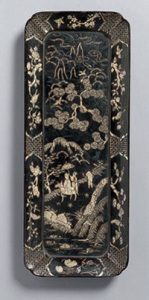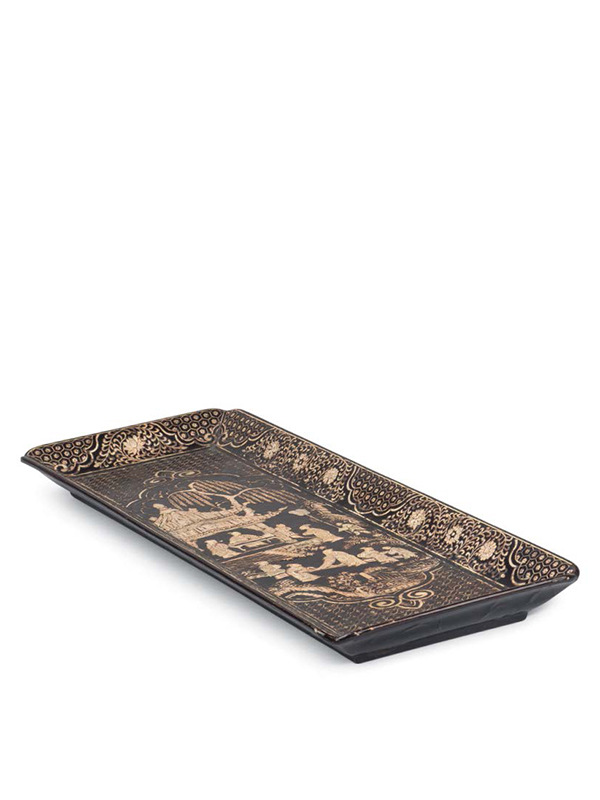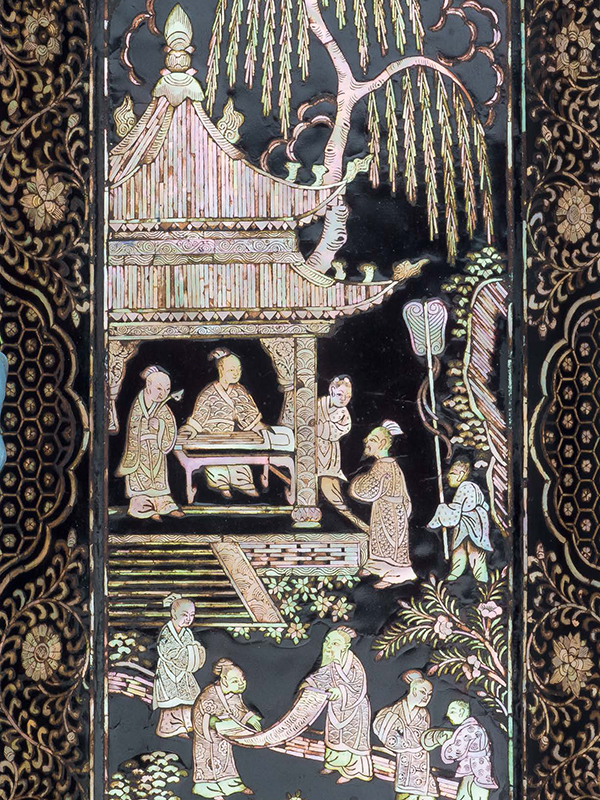Mother-of-pearl inlaid lacquer tray
A rectangular lacquer tray inlaid in mother-of-pearl, with indented corners and slightly flared rims, supported on a short foot. The centre of the flat surface depicts scholars in a garden setting. In a tiled pavilion on the upper left under a willow tree, a seated figure plays a string instrument. In front of the pavilion, a group of scholars examines a scroll painting. The scene is contained within a bracketed cartouche. The flared sides are decorated with scrolling flower blossoms amongst swirling tendrils, interspersed with shaped panels containing hexagonal diapers. The exterior is lacquered black. The tray is contained in a silver pouch and a Japanese wooden box.

Fig. 1 Mother-of-pearl inlaid lacquer tray, Victoria & Albert Museum
Furniture and daily utensils inlaid with mother-of-pearl were used by the upper classes of the Northern Song dynasty (960 – 1127). The technique became popular with ordinary people during the Yuan dynasty (1279 – 1368), and came to a crescendo during the Ming dynasty. Heavily influenced by jiehua, a kind of painting style with detailed architectural motifs, the design of Yuan to early Ming dynasty pieces appears with buildings as major elements and with figures playing a subordinate role.[1] This type of rectangular tray with shallow sides was most possibly used for folded scrolls, as its name zhoupan (‘scroll tray’) suggests. Two examples dated earlier to the 14th century of the Yuan dynasty, decorated with a comparable hexagonal ground, are in the Tokugawa Art Museum.[2] Two comparablenMing dynasty examples, both similar in the cartouche design and interlaced coin pattern, are in the Muwen Tang collection; one is especially comparable with the jiehua style design.3 Three further examples are dated between the 15th and 16th century: one similar in the cartouche design and depicting a dragon amongst waves is in the Klaus F. Naumann collection; [4] one depicting a landscape scene is in the collection of the Victoria and Albert Museum;[5] one depicting figures in a landscape setting with a closely comparable floral scrolling design on the sides is in the Garner collection and was exhibited at the British Museum in 1973.[6]
Provenance: private collection, Japan
- Kwan, S. Chinese Mother–of-Pearl, The Muwen Tang Collection Series, Muwen Tang Fine Arts Publications Ltd, Hong Kong, 2009, p. 35
- Karamono: Imported Lacquerwork – Chinese, Korean and Ryukyuan (Okinawa), Selections from The Tokugawa Art Museum vol. II, nos. 124, 125, pp. 68, 69
- Kwan, S. op. cit. nos. 37 and 62, pp. 118-9, 182-3
- Velt, W. A Japanese Taste for Lacquer – The Klaus F. Naumann Collection, Museum für Ostasiatische Kunst, Berlin, no. 59, pp. 150-1
- Krahl, R. From Innovation to Conformity-Chinese Lacquer from the 13th to 16th centuries, Bluett & Sons, London, 1989, no. 32, p. 82
- Chinese and Associated Lacquer from the Garner Collection, the British Museum, London, 1973, no. 129, pl. 50c, p. 38
黑漆嵌螺鈿撫琴賞畫圖長方形軸盤
明 十五 – 十六世紀 長: 39公分 寬:14 公分 高:2.7公分
黑漆嵌螺鈿軸盤,長方形,盤面上下以菱花邊紋開光,開光內以細螺鈿片描繪出文人雅士齊聚一
堂,前景庭院中央有二文人展畫細閱,身旁侍童垂手而立 ; 後方涼亭內一文人撫琴,琴聲方落即
起身相迎來訪友人。垂柳掩映春色,雲彩漂浮天際,歡樂閒逸之情盡顯。盤面開光外滿飾毬路
紋,盤內側飾以纏枝花卉紋,整體視覺對稱平衡,扶疏有致。盤外側與盤底髹以黑漆。類似作品
可見英國維多利亞與亞伯特博物館藏一件明代黑漆嵌螺鈿山水人物圖長方型軸盤。
來源:日本私人收藏


